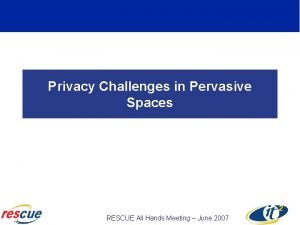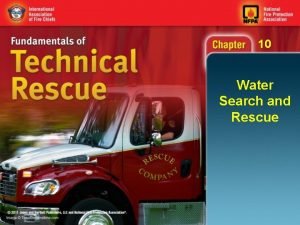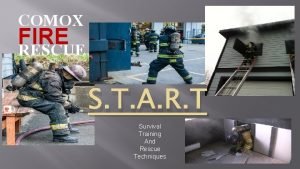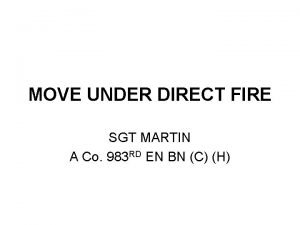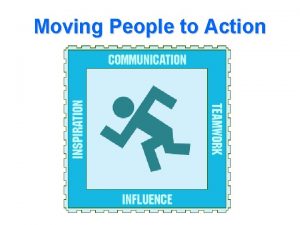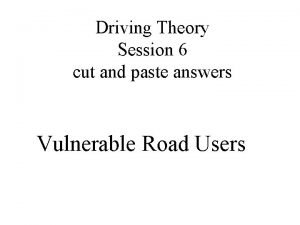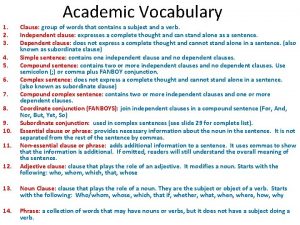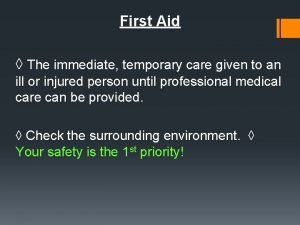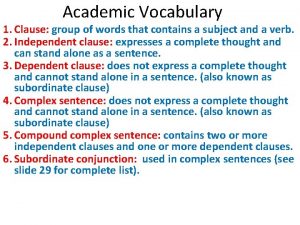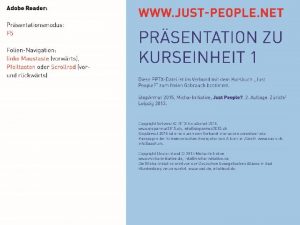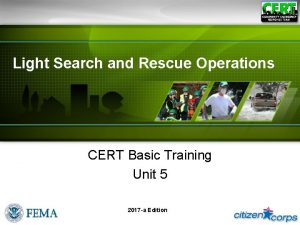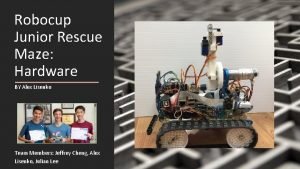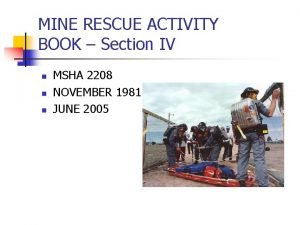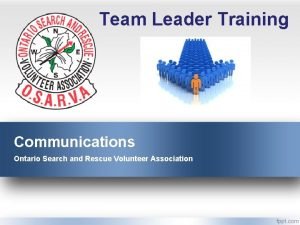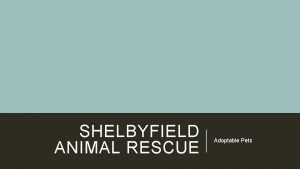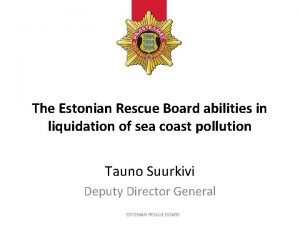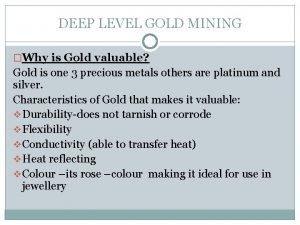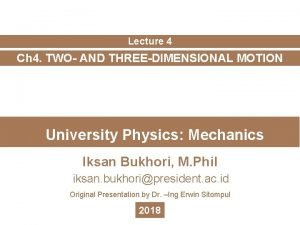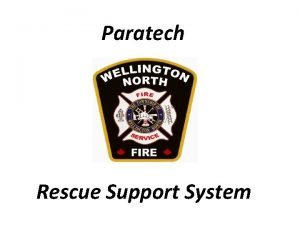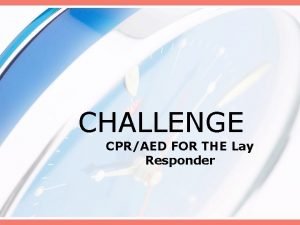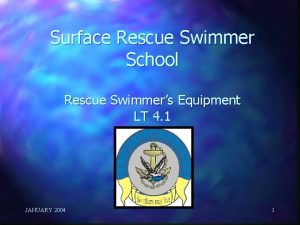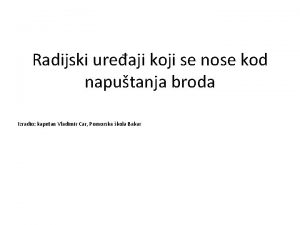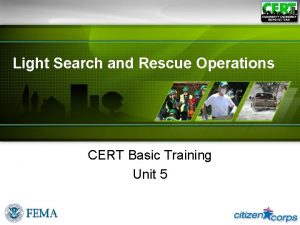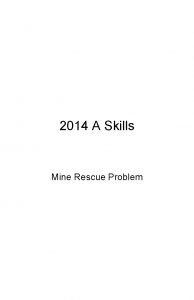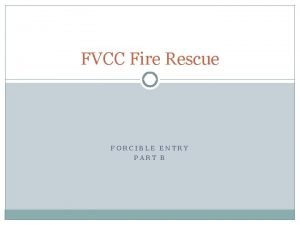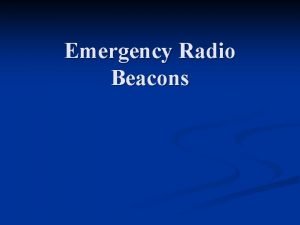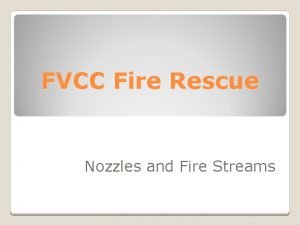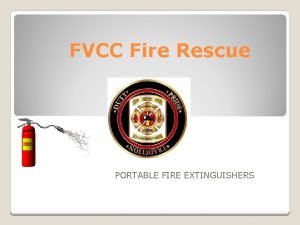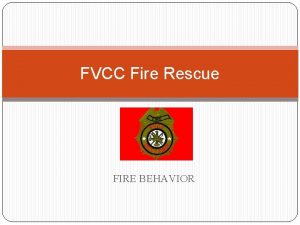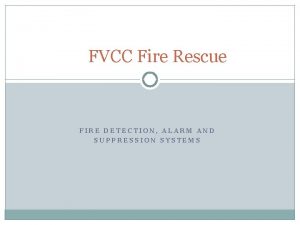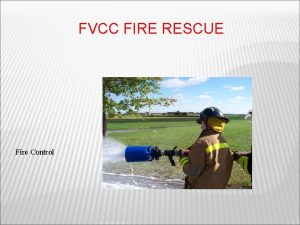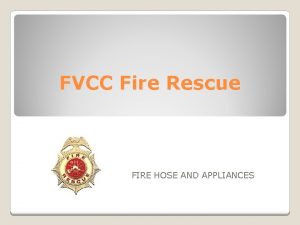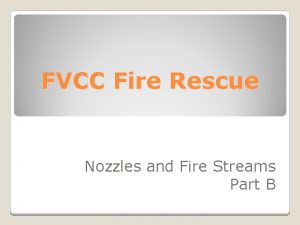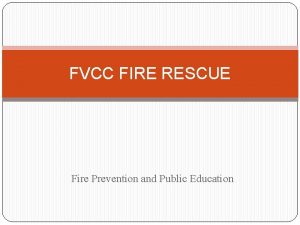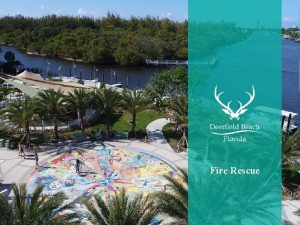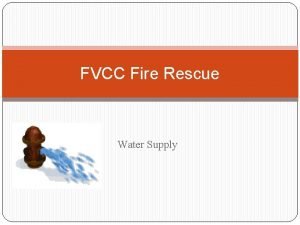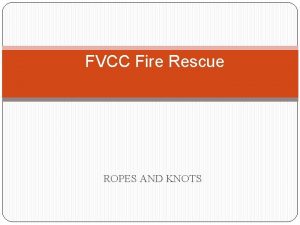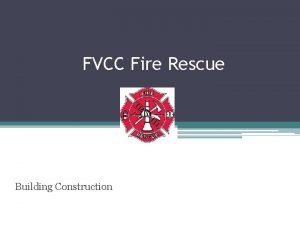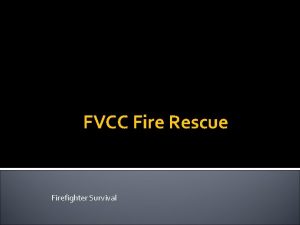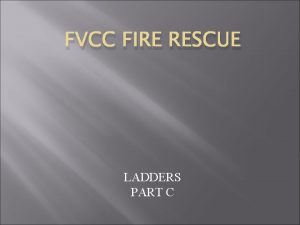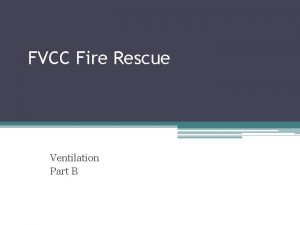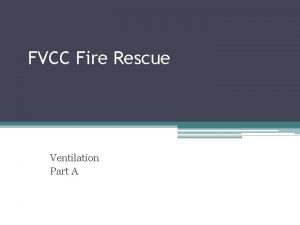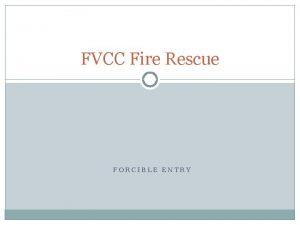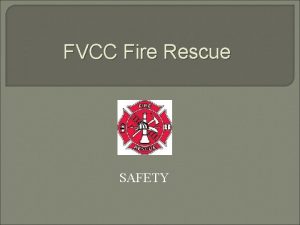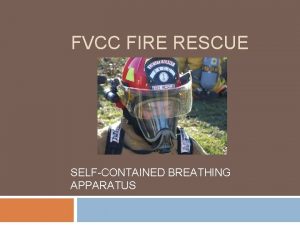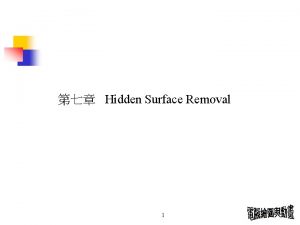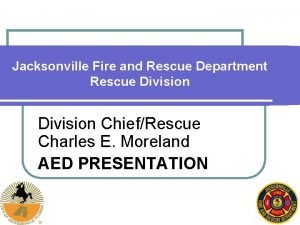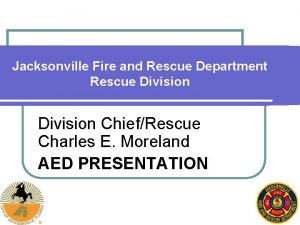FVCC Fire Rescue Moving Injured People REMOVAL OF












































- Slides: 44

FVCC Fire Rescue Moving Injured People

REMOVAL OF INJURED PERSONS BY USE OF CARRIES • Lone Rescuer Lift and Carry ▫ Push the victim’s feet close to their buttocks ▫ Hold them in place with their feet ▫ Grasp the victim’s hands and rocks the victim up and down several times to obtain greater momentum ▫ When ready, at the top of the upswing, jerk the victim up and onto the shoulder


REMOVAL OF INJURED PERSONS BY USE OF CARRIES • Extremities (sit-pick) Carry ▫ Rescuer #1 �Stand at the head of the victim �Kneel and slip the arms under the victim’s arms and around chest, grasping the victim’s wrists �Stand carry the victim to a place of safety, remembering to bend the knees when lifting ▫ Rescuer #2 �Stand at the victim’s feet �Kneel with feet together between the victim’s legs and grasp the victim under or just above the knees �Stand carry the victim to a place of safety, remembering to bend the knees when lifting






REMOVAL OF INJURED PERSONS BY USE OF CARRIES • Carrying a litter ▫ Position themselves at opposite ends of the litter facing the same direction ▫ Bend at the knees ▫ Grasp the handles or rails of the litter ▫ Raise to a full standing position with backs straight ▫ Move at a steady pace, keeping the litter level

REMOVAL OF INJURED PERSONS BY USE OF CARRIES • Moving a victim on a long backboard ▫ Rescuer #1 �Apply axial traction ▫ Rescuer #2 �Apply cervical collar �Prepare backboard �Place it alongside and parallel to victim ▫ Other rescuers �Kneel one side of victim �One at head �One at waist �One at knees

REMOVAL OF INJURED PERSONS BY USE OF CARRIES ▫ Rescuers grasp victim �Rescuer at victims shoulders, grasp the victim’s opposite shoulder and upper arm �Rescuer at the victims waist, grasp the victim’s waist and buttocks on the opposite side �Rescuer at victims knees, grasp the victim’s lower thing and calf on the opposite side ▫ At the direction of Rescuer #1, the rescuers gently roll the victim towards them ▫ Rescuer at the waist reaches across the victim’s body with one hand pulls the backboard against the victim

REMOVAL OF INJURED PERSONS BY USE OF CARRIES ▫ Rescuer #1 direct the others to roll the victim onto the backboard ▫ Rescuer #1 gives command to position the victim in the center of the backboard ▫ Rescuer at the victim’s shoulders, immobilize the victim’s head ▫ Each of the rescuers fasten the victim to the backboard with the appropriate strap










REMOVAL OF INJURED PERSON BY USE OF DRAGS • Blanket drag ▫ Rescuer places a bunker coat or blanket beside the face-up victim ▫ Gathers one edge of the blanket close to the victim’s side ▫ Rolls the victim towards them and while supporting the victim, gathers the coat or blanket underneath ▫ Rolls the victim onto the coat or blanket and smoothes it out. ▫ Grasps the coat or blanket on each side of victim’s head and raise enough to clear head and shoulders off the floor. Drags the victim to safety.







REMOVAL OF INJURED PERSON BY USE OF DRAGS • Clothing Drag ▫ Rescuer places victim on back arranging clothing to support head and neck checking to make sure victim’s breathing is not compromised ▫ Rescuer grasps the top of victim’s clothing, supporting the head with forearms ▫ Drags should be done keeping victim’s head close to floor to keep from compromising victim’s breathing


REMOVAL OF INJURED PERSON BY USE OF DRAGS • Webbing Sling Drag ▫ Webbing needs to be tied, using a water knot with safety, end to end forming a continuous loop ▫ With victim lying on back, loop is placed under each arm, coming up under the victim’s armpits ▫ Rescuer adjusts the loops to the loop coming out the underside of victim’s armpits till snug against the victim’s back ▫ Rescuer feeds the longer loop through between the body and the other webbing loop ▫ Rescuer drags the victim making sure the webbing under armpits is snug and longer loop provides some support to victim’s head

REMOVAL OF INJURED PERSON BY USE OF DRAGS • Sit and Drag Method ▫ Rescuer places victim in a face up position ▫ Rescuer assumes a sitting position at the head of the victim, with legs to each side and hands on either side of victim ▫ Rescuer grasps the victim under the arms, and pulls victim closely so the victim’s head and back are against rescuer’s chest and the rescuer’s things are under the victim’s armpits, with the patient’s arms outside of the rescuer’s legs

REMOVAL OF INJURED PERSON BY USE OF DRAGS ▫ Rescuer removes victim by sliding backward in the sitting position and using the legs to drag the patient along. • Firefighter’s drag ▫ Rescuer places victim in a face up position ▫ Rescuer ties victim’s wrists together using a piece of rope, webbing, belt or other available material. ▫ Rescuer straddles the victim, facing him/her, and places the bound wrists over the rescuer’s head and behind the neck.

REMOVAL OF INJURED PERSON BY USE OF DRAGS ▫ Rescuer crawls on hands and knees while dragging the victim out of area. ▫ In some cases (large or pregnant victim) the rescuer will have to crawl beside the victim • Rescue of firefighter wearing SCBA ▫ Determine if SCBA is functional �If not, disconnect the low-pressure tube and place it inside the victim’s coat or remove the regulator from the face piece, leaving the face piece in place. ▫ Roll the victim onto his/her side, ensuring the air supply is not compromised.

REMOVAL OF INJURED PERSON BY USE OF DRAGS ▫ Verify that the SCBA is securely fastened on the victim. ▫ Grasp the shoulder straps of the victim’s SCBA and drag him from the area.

Homework Distinguish between rescue and extrication operations. Mark “A” before each extrication operation below and “B” for each rescue operation. 1. Child trapped in a well shaft 2. Boater trapped in the hydraulic of a low-head dam 3. Driver trapped in a crushed vehicle 4. Pedestrian trapped under a collapsed bridge span 5. Child with head trapped in a vending machine 6. Hiker trapped on a mountainside cliff 7. Worker trapped in a collapsed construction trench 8. Employee trapped in a collating machine 9. Office workers trapped in a stalled elevator car in a burning building 10. Farmer trapped under a tractor

TS 7– 4 Homework Distinguish between primary search and secondary search operations. Mark “A” before each primary search operation below and “B” for each secondary search operation. 11. Conduct before or during fire suppression operations 12. Be rapid but thorough 13. Is conducted by personnel other than those who conducted primary search 14. Is thorough and painstaking 15. Is conducted after fire is under control and hazards are somewhat abated 16. Look in known or likely locations for victims 17. Verify fire conditions 18. Report surprises

Homework Select guidelines for rescue from burning buildings. Write the correct letters on the blanks. 19. When sizing up a building, where should firefighters first seek information about victims who might still be inside? a. From pre-incident surveys b. From neighbors c. From posted occupancy signs d. From occupants who have escaped the fire 20. What is the best way of descending stairs in heavy smoke? a. On hands and knees, feet first b. Walking forward c. On hands and knees, head first d. Walking sideways 21. How should firefighters conduct a search on the fire floor? a. Beginning at the entrance door and working in a circuit b. Beginning as far away from the fire as possible and working toward it c. Beginning and ending at the midpoint between the fire and the entrance door d. Beginning as close to the fire as possible and working toward the entrance door 22. Firefighter A says that rescuers should search bathtubs, shower stalls, under beds and behind furniture. • Firefighter B says that rescuers should first search the perimeter of a room and then the middle. • Who is right? a. Firefighter A b. Firefighter B c. Both A and B d. Neither A nor B 23. When performing building search and rescue, the rescuer should keep in constant verbal or visual contact with a. Rapid intervention crew members b. A water source c. Team member(s) d. Ventilation team members

Homework 24. Why should rescuers report that smoke is obscuring their vision? a. It might indicate a need for additional ventilation. b. It might indicate a need to withdraw from the building. c. It might indicate a need for additional fire streams. d. It might indicate a need for an additional alarm. 25. When searching a building, what should the firefighter look for and report to the commanding officer? a. Any extension of fire b. Any fire extinguishers c. Any smoke d. Open windows 26. Firefighter A says that the personnel who conducted the primary search should not conduct the secondary search. • Firefighter B says that the secondary search is conducted as systematically as the primary search. • Who is right? a. Firefighter A b. Firefighter B c. Both A and B d. Neither A nor B 27. Which areas are the most critical when searching a multistory building? a. The fire floor and the floors directly above and below it b. The fire floor and the next two floors above it c. The fire floor, the ground floor, and the topmost floor d. The fire floor, the floor directly above it, and the topmost floor 28. Which of the following statements accurately describes how rescuers should leave a room? a. To continue their search, they should turn in the opposite direction they used to enter the room. b. To remove a victim to safety, they should turn in the same direction they used to enter the room. c. If a room has two doors, they should enter through one door and exit through the other. d. They should exit through the same door that they entered.

Homework 29. Which method of searching a small room reduces the likelihood of rescuers becoming lost? a. Both search the room in the same direction. b. Both take turns searching the room or waiting at the door. c. Both search the room in opposite directions. d. One is assigned to search all rooms while the other waits at the door. 30. Which is a recommended method of marking rooms that have been searched? a. Marking the door with chalk or crayon b. Blocking the door open with furniture c. Marking the floor just inside the door with masking tape d. Making a shallow X on the door with an axe 31. Which of the following are not typical search and rescue tools? a. Marking devices b. Portable extinguishers c. Forcible entry tools d. Ropes 32. Which parts of a door should searchers feel to determine the heat level within a room? a. The top and the bottom b. The top and the doorknob c. The doorknob and the opposite side d. The bottom and both sides 33. What should firefighters do if an inward-opening door is difficult to open? a. Kick it open b. Force it with a maul c. Push it open slowly d. Close it

Homework Select facts about firefighters who become trapped or disoriented. Write the correct letters on the blanks. 34. If possible, what is the best action for firefighters who become disoriented? a. Remain stationary and call for help b. Try to seek an exit from the building. c. Find a window and throw out their PASS device d. Try to retrace their steps to their original locations. 35. What should firefighters do if they become exhausted or close to losing consciousness in a building? a. Sit up against an interior wall. b. Lie on the floor next to an exterior wall, hall, or doorway. c. Lie as low as possible in the middle of the room. d. Practice controlled breathing until they regain their strength and then move on. 36. What should rescuers do first when searching for a lost or disoriented firefighter? a. Try to quickly determine the last location of the firefighter. b. Mark their own point of entry. c. Call for an emergency medical technician d. Activate their PASS devices.

Homework 37. What should rescuers do if it becomes necessary to remove a downed firefighter? a. Stabilize injuries before removing the firefighter. b. Call for a backboard or litter. c. Use any safe means possible. d. Activate the firefighter’s PASS device. 38. During a building search and rescue, at no time should the rescuer remove his or her ___ in an attempt to share it with another firefighter or victim. a. PASS device b. Helmet c. Facepiece d. Backpack 39. Which circumstance would not necessitate an emergency move? a. Explosives or other hazardous materials are involved. b. It is impossible to protect the accident scene. c. The victim is unconscious but otherwise stable. d. There is danger of fire in the immediate area. 40. What is the chief danger in moving a victim quickly? a. Inducing cardiac arrest b. Deterring cardiopulmonary resuscitation c. Aggravating a spinal injury d. Encouraging heavy bleeding

Homework Select facts about victim removal. Write the correct Letters on the blanks. 41. Which of the following is the best way to perform an emergency move? a. Pull the victim sideways. b. Jackknife the victim. c. If the victim is on the floor, pull the victim’s feet. d. Pull in the direction of the long axis of the body. 42. Firefighter A says that lifting incorrectly is not a common cause of injury to rescuers. • Firefighter B says that if immobilization of a fracture is not feasible, both rescuers should support the weight of the injured part while moving the victim. • Who is right? a. Firefighter A b. Firefighter B c. Both A and B d. Neither A nor B 43. Firefighter A says that the extremities lift/carry can be used on either a conscious or unconscious victim. • Firefighter B says that the chair lift/carry should be used only for a conscious victim. • Who is right? a. Firefighter A b. Firefighter B c. Both A and B d. Neither A nor B 44. Who directs the actions when rescuers suspect a victim has a spinal injury? a. A rescuer not actually involved in lifting the victim b. The rescuer at the victim’s head c. The rescuer who maintains in-line stabilization d. The rescuer at the victim’s feet
 Fvcc dorms
Fvcc dorms Rethrog
Rethrog Comox fire department
Comox fire department Movement under direct fire
Movement under direct fire Moving people to action
Moving people to action At night you see a pedestrian wearing reflective
At night you see a pedestrian wearing reflective We can wait here until carlo calls us
We can wait here until carlo calls us Multiply injured patient
Multiply injured patient It is an immediate and temporary care given
It is an immediate and temporary care given Objective of a first aider
Objective of a first aider Juan continued playing although he injured his knee
Juan continued playing although he injured his knee Fight fire with fire definition
Fight fire with fire definition Ire fire fire rwi
Ire fire fire rwi Reichstag fire who was the fire starter
Reichstag fire who was the fire starter Damper interface panel
Damper interface panel Uttar pradesh fire prevention & fire safety rules, 2005
Uttar pradesh fire prevention & fire safety rules, 2005 Demeter realm
Demeter realm Recovery community
Recovery community Justpeople
Justpeople People as media and people in media examples
People as media and people in media examples People killin people dying
People killin people dying Flossies kitten rescue
Flossies kitten rescue Light search and rescue
Light search and rescue Rescue maze
Rescue maze Confined space powerpoint
Confined space powerpoint Mine rescue 7-19
Mine rescue 7-19 Walk 2. ve 3. hali
Walk 2. ve 3. hali Ontario search and rescue volunteer association
Ontario search and rescue volunteer association Shelbyfield animal rescue
Shelbyfield animal rescue Tauno suurkivi
Tauno suurkivi Deep sea mining
Deep sea mining A rescue plane flies at 198 km/h
A rescue plane flies at 198 km/h Mine rescue 9-3
Mine rescue 9-3 Paratech rescue struts
Paratech rescue struts Rescue breaths for child with pulse
Rescue breaths for child with pulse Rescue swimmer equipment
Rescue swimmer equipment Epirb uređaj
Epirb uređaj Leveraging and cribbing
Leveraging and cribbing Giles county va animal shelter
Giles county va animal shelter Mine rescue 24-10
Mine rescue 24-10 Mine rescue 19-1
Mine rescue 19-1 Forcible door entry device factory
Forcible door entry device factory Embryo rescue
Embryo rescue Beacon
Beacon Animal angel rescue foundation
Animal angel rescue foundation
